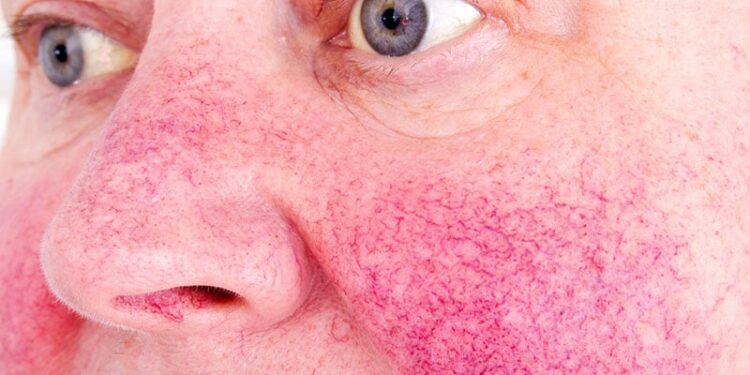As a steady stream of studies suggests associations between rosacea and comorbidities, ranging from cardiovascular disease to depression and gastrointestinal (GI) issues, patients may look to their dermatologists for guidance on how to interpret these findings.
“The co-occurrence of rosacea and systemic disease is far from definitive, and the majority of patients presenting with rosacea do not have an associated comorbidity,” Hilary Baldwin, MD, director of the Acne Treatment & Research Center, Brooklyn, New York, said in an interview. “My job as a dermatologist is to diagnose and treat the rosacea, uncover any potential comorbidities, and refer back to the primary care giver,” she added. “The last thing that I want to do is to panic the patient during the visit. This is particularly important in our current medical climate in which obtaining appointments with primary care physicians — or finding one if currently without — is met with unacceptable delays.”

Baldwin, a former president of the American Acne & Rosacea Society, was one of the authors of a 2018 review of rosacea comorbidities and their common physiologic pathways. This review and a 2017 update on the topic by the National Rosacea Society Expert Committee found that the most supportive data are available for cardiovascular and GI comorbidities. However, Baldwin pointed out that a comorbidity in a patient with rosacea “does not indicate any type of cause and effect,” she said. “It simply means that the diseases are present together. There are numerous diseases that have been found to co-exist with rosacea.”
According to Richard Gallo, MD, PhD, professor and chair of Dermatology at the University of California, San Diego, and senior author of the 2017 National Rosacea Society update, studies published in more recent years support strong associations between rosacea and dyslipidemia, inflammatory bowel disease and other GI issues, and depression. “These seem to come up most frequently,” he told this news organization. A 2024 study found an association between rosacea and the development of melanoma in White individuals. “That study needs some validation, but I think it’s something to keep an eye on,” Gallo said.

What remains unclear, he continued, is exactly why rosacea causes increased sensitivity of facial skin to the environment. “Some of the genes that we find in the skin of patients with rosacea link the innate immune system and the nervous system to being part of the trigger,” Gallo said. “We also know that neural signals and immune functions are systemic, so it’s reasonable to still hypothesize that facial rosacea could be a manifestation of other things that are systemically abnormal. But the opposite is also true.”
For example, he and colleagues have demonstrated that the facial skin of patients with rosacea has an abundance of a peptide known as LL-37, which has antimicrobial and proinflammatory properties. “LL-37 is also abundant in psoriasis,” Gallo noted. “We’ve recently shown in mouse models that LL-37 can directly cause atherosclerotic plaques to build up.”
Julie C. Harper, MD, a dermatologist who practices in Birmingham, Alabama, and is editor of the Rosacea Review newsletter, said that every patient with rosacea that she sees completes a review of systems, which “should flag any comorbidities that are already present.” Noting that depression and anxiety are frequently reported with rosacea, “ensuring that rosacea patients have a primary care provider that can monitor cardiovascular risk factors is reasonable,” she told Medscape Medical News. “But we really don’t have enough evidence to suggest that all rosacea patients need to be screened additionally for neurological, GI, or cardiovascular disease at this time.”
While patients with rosacea are predisposed to an exaggerated inflammatory response to environmental and microbial triggers, Harper said, not all of these triggers directly affect the skin. “For example, the ingestion of some foods can trigger inflammation in rosacea,” she said. “These observations should make us wonder about more extra-cutaneous inflammation. It is plausible that rosacea is one manifestation of a more widespread, systemic inflammatory condition. I certainly have patients with more than one disease, but identifying and treating rosacea as an early indicator of these diseases will be difficult in the clinic setting.”
For now, she continued, the best course of action is to identify and manage the clinical findings well. “We do this by matching our treatments mechanistically to the clinical features that we see. This will almost always include anti-inflammatory medications.”
Baldwin added that a patient who is already being treated for cardiovascular or GI disease “has little to gain” from pointing out the possible association with rosacea. “The patient who can benefit from my intervention is the one in whom the symptoms are new or as yet unexplored.”
She recalled one patient with rosacea for whom referral was fruitful — a man with a history of bloating, excessive flatulence, and abdominal pain presumed to be lactose intolerance. “Dairy avoidance was unhelpful in controlling his symptoms,” Baldwin said. Referral to a gastroenterologist resulted in the diagnosis of small intestinal bacterial overgrowth and subsequent treatment with rifaximin resolved both his GI and cutaneous symptoms.
In an asymptomatic patient, Gallo said, the common comorbidities typically associated with rosacea are not severe enough to require an immediate referral. “However, it’s a warning sign, so you want to alert the patient to think about these things, making sure they’re plugged into a doctor, making sure their doctor is aware of it,” he said. “Those are important steps.”
Gallo disclosed that he is a member of the board of the National Rosacea Society. Baldwin disclosed being a speaker, consultant, and/or an advisory board member for Almirall, Arcutis Biotherapeutics, Bausch, Beiersdorf, Cutera, Galderma, Journey, Kenvue, La Roche-Posay, L’Oréal, Sanofi, Sun Pharmaceutical Industries, and Tarsus. Harper disclosed being a speaker, consultant, and/or an advisory board member for Almirall, Cutera, Galderma, Journey, Ortho Dermatologics, and Sun Pharmaceutical Industries.
Source link : https://www.medscape.com/viewarticle/what-make-comorbidities-linked-rosacea-2025a10001qx?src=rss
Author :
Publish date : 2025-01-24 04:36:07
Copyright for syndicated content belongs to the linked Source.














